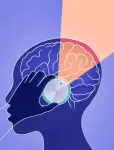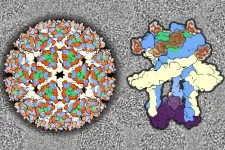(Press-News.org) Consider the cornea if you will – and most people won’t unless they’re having a problem. It is the transparent front surface of the eye which allows vision by focusing light as it enters. The cornea is densely packed with multi-tasking nerves that mediate pain, blink reflexes and tear production, all indispensable tasks in the proper maintenance of ocular surface health. Because it is highly innervated, meaning it has a lot of nerve connections, the cornea is a key area for understanding sensory functions.
But it is that same complexity which has made it increasingly difficult to grasp the full nature of how those corneal nerves work, resulting in key knowledge gaps in the field. A University of Houston optometrist researcher is set to fill in the gaps by mapping the cornea and providing a comprehensive analysis of corneal nerves at the morphologic, molecular and functional level.
“We are developing methods to selectively label the neurons that innervate the cornea. These neurons make up about 1% of the population of neurons located in the trigeminal ganglia, the peripheral nervous system that mediates pain and other sensory functions,” said Anna Matynia, associate professor at the University of Houston College of Optometry.
Matynia has received $1.4 million from Duke University via the National Eye Institute to explore new approaches to disentangle these intricate networks and discover which nerve makes people blink, which creates tears and which nerve tells us our eye is in pain.
Matynia and her team are using advanced imaging, studying genes, and using computers to map the corneal nerves. They are also figuring out which nerves connect directly to the eye and creating a detailed map of how they're all connected.
“These efforts will provide critical clues for understanding corneal structure-function and will lead to an unprecedented cartography,” said Matynia. “The advancements from this work will be poised to facilitate a deeper understanding of related pathobiology including neuropathic ocular pain and dry eye disease that will lay the foundation for future translational and clinical research.”
Matynia’s team includes Daniel R. Saban, Duke University and Victor Perez, University of Miami.
END
UH optometrist receives $1.4 million to map the cornea
Unlocking the secrets of blinking, tearing, and pain sensation could improve understanding of dry eye disease
2024-01-03
ELSE PRESS RELEASES FROM THIS DATE:
Researchers identify path to prevent cognitive decline after radiation
2024-01-03
Researchers at the Del Monte Institute for Neuroscience at the University of Rochester find that microglia—the brain’s immune cells—can trigger cognitive deficits after radiation exposure and may be a key target for preventing these symptoms. These findings, out today in the International Journal of Radiation Oncology Biology Biophysics, build on previous research showing that after radiation exposure microglia damage synapses, the connections between neurons that are important for cognitive ...
Mount Sinai study shows that human beliefs about drugs could have dose-dependent effects on the brain
2024-01-03
Mount Sinai researchers have shown for the first time that a person’s beliefs related to drugs can influence their own brain activity and behavioral responses in a way comparable to the dose-dependent effects of pharmacology.
The implications of the study, which directly focused on beliefs about nicotine, are profound. They range from elucidating how the neural mechanisms underlying beliefs may play a key role in addiction, to optimizing pharmacological and nonpharmacological treatments by leveraging the power of human beliefs. The study was published in the journal Nature Mental Health.
“Beliefs can have a powerful influence on our behavior, ...
Chronic childhood ear infections delay language development
2024-01-03
Ear infections are a common childhood experience, but a new study suggests parents should take these infections seriously to preserve their children’s language development. That’s because each ear infection can potentially impair hearing with fluid building up behind the eardrum.
New research from University of Florida scientists reveals that when ear infections become chronic, this repeated, temporary hearing loss can lead to deficits in auditory processing and language development in children years later.
“Ear ...
Inpatient costs of treating patients with COVID-19
2024-01-03
About The Study: In this study of more than 1.3 million inpatient admissions for treatment of COVID-19 from March 2020 through March 2022, researchers estimated an average national medical resource use or hospital cost to deliver care per COVID-19 inpatient stay at $11,275. Hospital costs increased more than five times the rate of medical inflation over this period. This was explained partly by changes in the use of extracorporeal membrane oxygenation, which also increased over time. Nonetheless, costs to provide inpatient care increased even as care practices changed, vaccination rates increased, and the variants of concern evolved.
Authors: Kandice A. ...
Online racial discrimination, suicidal ideation, and traumatic stress in a national sample of Black adolescents
2024-01-03
About The Study: This study that included 525 Black adolescents found an association between individual online racial discrimination and posttraumatic stress disorder symptoms and between posttraumatic stress disorder symptoms and suicidal ideation. These risk factors are important to consider in continuing studies of the cause of suicidal ideation for Black adolescents in the U.S.
Authors: Brendesha M. Tynes, Ph.D., of the University of Southern California, Los Angeles, is the corresponding author.
To ...
Cost of hospital care for COVID-19 patients increased during pandemic
2024-01-03
The average cost of providing care to hospitalized COVID-19 patients increased five times faster than the rate of medical inflation during the first two years of the pandemic, at least partly because of the application of additional medical technologies over the period, according to a new RAND Corporation study.
Examining patients treated at academic medical centers across the nation, researchers found that the average cost of treatment for COVID-19 infection increased from $10,094 during the first weeks of the pandemic to $13,072 during March 2022.
Significant ...
Epilepsy drug shows promise in slowing joint degeneration in osteoarthritis
2024-01-03
New Haven, Conn. — Yale researchers have identified a drug target that may alleviate joint degeneration associated with osteoarthritis, a debilitating condition that afflicts as many as 30 million people in the United States alone, which they report on Jan. 3 in the journal Nature.
Pain relievers and lifestyle changes, such as exercise and reduced excess weight, have long been the therapies most commonly used to treat the joint stiffness and pain caused by degenerative disease, but there ...
Researchers create first functional semiconductor made from graphene
2024-01-03
Researchers at the Georgia Institute of Technology have created the world’s first functional semiconductor made from graphene, a single sheet of carbon atoms held together by the strongest bonds known. Semiconductors, which are materials that conduct electricity under specific conditions, are foundational components of electronic devices. The team’s breakthrough throws open the door to a new way of doing electronics.
Their discovery comes at a time when silicon, the material from which ...
Study reveals clues to how Eastern equine encephalitis virus invades brain cells
2024-01-03
An atomic-level investigation of how Eastern equine encephalitis virus binds to a key receptor and gets inside of cells also has enabled the discovery of a decoy molecule that protects against the potentially deadly brain infection, in mice.
The study, from researchers at Washington University School of Medicine in St. Louis, is published Jan. 3 in the journal Cell. By advancing understanding of the complex molecular interactions between viral proteins and their receptors on animal cells, the findings lay a foundation for treatments and vaccines ...
Unraveling the mysteries of the Mongolian Arc: exploring a monumental 405-kilometer wall system in Eastern Mongolia
2024-01-03
New study sheds light on the previously overlooked Mongolian Arc—a monumental wall system in eastern Mongolia spanning 405 kilometers. This discovery not only reveals the significance of this ancient architectural marvel but also prompts crucial questions about the motives, functionality, and broader implications of such colossal constructions. Their findings contribute to a larger multidisciplinary project exploring historical wall systems and their socio-political, economic, and environmental impacts, marking a pivotal milestone in understanding ancient civilizations and their enduring legacies.
[Jerusalem, ...
LAST 30 PRESS RELEASES:
Otago experts propose fiber as first new essential nutrient in 50 years
Auburn Physics PhD student earns prestigious DOE Fellowship
AI tool helps you learn how autistic communication works
To show LGBTQ+ support, look beyond Pride Month
Using artificial intelligence to understand how emotions are formed
Exposure to wildfire smoke late in pregnancy may raise autism risk in children
Breaking barriers in lymphatic imaging: Rice’s SynthX Center leads up to $18 million effort for ‘unprecedented resolution and safety’
Dhaval Jadav joins the SETI Institute Board to help spearhead novel science and technology approaches in the search for extraterrestrial life
Political writing retains an important and complex role in the national conversation, new book shows
Weill Cornell Medicine receives funding to develop diagnostic toolbox for lymphatic disease
It started with a cat: How 100 years of quantum weirdness powers today’s tech
McGill researchers identify a range of unexpected chemical contaminants in human milk
Physical therapy research highlights arthritis’ toll on the workforce — and the path forward
Biomedical and life science articles by female researchers spend longer under review
Forgetting in infants can be prevented in mice by blocking their brain’s immune cells
Blocking immune cells in the brain can prevent infant forgetting
AI-driven ultrafast spectrometer-on-a-chip: A revolution in real-time sensing
World enters “era of global water bankruptcy”; UN scientists formally define new post-crisis reality for billions
Innovations in spatial imaging could unlock higher wheat yields
A twitch in time? Quantum collapse models hint at tiny time fluctuations
Community water fluoridation not linked to lower birth weight, large US study finds
Stanford University’s Guosong Hong announced as inaugural recipient of the SPIE Biophotonics Discovery’s Impact of the Year Award
Ice, ice, maybe: There’s always a thin layer of water on ice — or is there?
Machine learning lends a helping ‘hand’ to prosthetics
Noninvasive brain scanning could send signals to paralyzed limbs
Community water fluoridation and birth outcomes
SGLT2 inhibitors vs GLP-1 receptor agonists for kidney outcomes in individuals with type 2 diabetes
Long-term exposure to air pollution and risk and prognosis of motor neuron disease
Five-year absolute risk–based and age-based breast cancer screening in the US
Study finds elevated alcohol involvement in suicides of lesbian, gay and bisexual women
[Press-News.org] UH optometrist receives $1.4 million to map the corneaUnlocking the secrets of blinking, tearing, and pain sensation could improve understanding of dry eye disease





